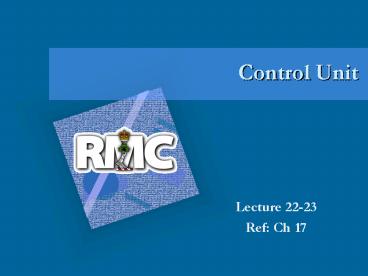Control Unit - PowerPoint PPT Presentation
1 / 26
Title:
Control Unit
Description:
Jump Condition. System Bus. Control Signals. Jump Conditions: Unconditional ... Based on current microinstruction, condition flags, contents of IR, control ... – PowerPoint PPT presentation
Number of Views:60
Avg rating:3.0/5.0
Title: Control Unit
1
Control Unit
- Lecture 22-23
- Ref Ch 17
2
Outline
- Review
- Micro-Programmed Implementation
- Vertical Micro-Programming
- Horizontal Micro-Programming
- Control Unit
3
Review
- Micro-Ops
- Fetch, Interrupt, Execute
- Control Unit Function
- Hard-Wired Implementation
4
Micro-programmed Control
- Logic of the CU is specified by a microprogram
- A microprogram is a sequence of simple
instructions in a microprogramming language to
control complex operations - Each instruction corresponds to a micro-operation
- Called micro-programming or firmware
5
Implementation (1)
- All the control unit does is generate a set of
control signals - Each control signal is on or off
- Represent each control signal by a bit
- Have a control word for each micro-operation
- Have a sequence of control words for each machine
code instruction - Add an address to specify the next
micro-instruction, depending on conditions
6
Implementation (2)
- Todays large microprocessor
- Many instructions and associated register-level
hardware - Many control points to be manipulated
- This results in control memory that
- Contains a large number of words
- co-responding to the number of instructions to be
executed - Has a wide word width
- Due to the large number of control points to be
manipulated
7
Micro-program Word Length
- Based on 3 factors
- Maximum number of simultaneous micro-operations
supported - The way control information is represented or
encoded - The way in which the next micro-instruction
address is specified
8
Micro-instruction Types
- Each micro-instruction specifies many different
micro-operations to be performed in parallel - (horizontal micro-programming)
- Each micro-instruction specifies single (or few)
micro-operations to be performed - (vertical micro-programming)
9
Vertical Micro-programming
- Width is narrow
- n control signals encoded into log2 n bits
- Limited ability to express parallelism
- Considerable encoding of control information
requires external memory word decoder to identify
the exact control line being manipulated
10
Vertical Micro-programming diagram
Micro-instruction Address
Function Codes
Jump Condition
11
Horizontal Micro-programming
- Wide memory word
- High degree of parallel operations possible
- Little encoding of control information
12
Horizontal Micro-programmed diagram
Internal CPU Control Signals
Micro-instruction Address
System Bus Control Signals
Jump Condition
Jump Conditions Unconditional
Zero
Overflow
Indirect Bit
13
Compromise
- Divide control signals into disjoint groups
- Implement each group as separate field in memory
word - Supports reasonable levels of parallelism without
too much complexity
14
Control Memory
. Jump to Indirect or Execute
Fetch cycle routine
. Jump to Execute
Indirect Cycle routine
. Jump to Fetch
Interrupt cycle routine
Jump to Op code routine
Execute cycle begin
. Jump to Fetch or Interrupt
AND routine
. Jump to Fetch or Interrupt
ADD routine
15
Control Unit
16
Control Unit Function
- Sequence logic unit issues read command
- Word specified by control address register is
read into control buffer register - Control buffer register contents generates
control signals and next address information - Sequence logic loads new address into control
buffer register based on next address information
from control buffer register and ALU flags
17
Advantages and Disadvantages
- Simplifies design of control unit
- Cheaper
- Less error-prone
- Slower
18
Tasks Done By Microprogrammed Control Unit
- Microinstruction sequencing
- Microinstruction execution
- Must consider both together
19
Design Considerations
- Size of microinstructions
- Address generation time
- Determined by instruction register
- Once per cycle, after instruction is fetched
- Next sequential address
- Common in most designed
- Branches
- Both conditional and unconditional
20
Sequencing Techniques
- Based on current microinstruction, condition
flags, contents of IR, control memory address
must be generated - Based on format of address information
- Two address fields
- Single address field
- Variable format
21
Two Address Fields
22
Single Address Field
23
Address Generation
- Explicit Implicit
- Two-field Mapping
- Unconditional Branch Addition
- Conditional branch Residual control
24
Execution
- The microinstruction cycle is the basic event on
a micro-programmed processor - Each cycle is made up of two events
- Fetch
- Determined by generation of microinstruction
address - Execute
25
Execute
- Effect is to generate control signals
- Some control points internal to processor
- Rest go to external control bus or other
interface
26
Control Unit - Updated































